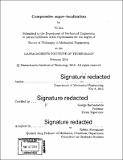Compressive super-localization
Author(s)
Liu, Yi, Ph. D. Massachusetts Institute of Technology
DownloadFull printable version (11.98Mb)
Other Contributors
Massachusetts Institute of Technology. Department of Mechanical Engineering.
Advisor
George Barbastathis.
Terms of use
Metadata
Show full item recordAbstract
Localization accuracy is a fundamental quantity of an imaging system, since it often determines the performance (e.g. effective resolution, sensitivity) of the system. This thesis studies the influence on localization accuracy of finite sampling rate, number of samples, and noise in the data acquisition process. Two classes of super-localization problems will be investigated. The first class of problem aims to improve the accuracy in localizing and tracking the physical position of an object of interest. For lateral localization problems, the key parameters to consider are the pixel size as compared to the size of the point spread function (PSF) of the imaging system, and to the amount of motion of the object of interest. If the pixel size is larger than PSF or object motion, accurate localization essentially becomes solving an under-sampling problem. In this thesis, a compressive holography algorithm is proposed to localize smaller than pixel size motion. 1/45 sub-pixel motion has been successfully detected. For axial localization problems, the localization accuracy will be affected not only by the pixel size and number of pixels, but also by the imaging geometry. Traditional axial localization methods are fundamentally limited by the finite numerical aperture of the optical system. In this thesis, a class of compressive reconstruction method that exploits the "sparse" prior knowledge about the object in order to alleviate the missing angular information has been investigated and 1/16 depth of field (DOF) axial displacement was successfully extracted. Successful implementation of the compressive holography based super-localization technique has been applied to image biomimetic sensors inspired by harbor sea seal whiskers for studying vortex-induced vibrations and wake-induced vibrations. The second class of super-localization problem under investigation is to detect weak signals buried under strong background and noise. A compressive reconstruction method that is able to detect signals captured with extremely low signal-to-noise ratio (SNR) and signal-to-background ratio (SBR), by exploiting different "sparsities" in the respective signal and background subspaces has been demonstrated.
Description
Thesis: Ph. D., Massachusetts Institute of Technology, Department of Mechanical Engineering, 2016. Cataloged from PDF version of thesis. Includes bibliographical references (pages 127-135).
Date issued
2016Department
Massachusetts Institute of Technology. Department of Mechanical EngineeringPublisher
Massachusetts Institute of Technology
Keywords
Mechanical Engineering.